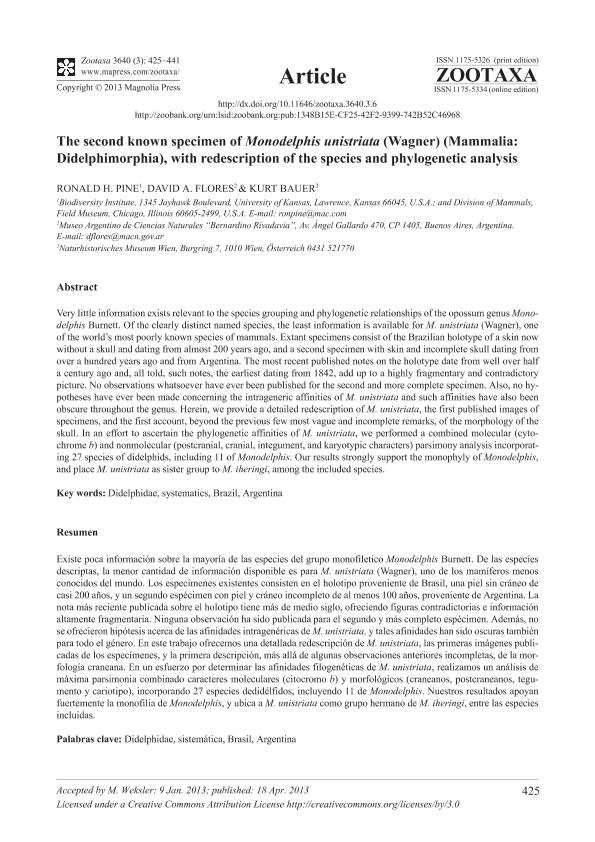Mostrar el registro sencillo del ítem
dc.contributor.author
Pine, Ronald H.
dc.contributor.author
Flores, David Alfredo

dc.contributor.author
Bauer, Kurt
dc.date.available
2016-11-29T18:13:42Z
dc.date.issued
2013-02
dc.identifier.citation
Pine, Ronald H.; Flores, David Alfredo; Bauer, Kurt; The second known specimen of Monodelphis unistriata (Wagner) (Mammalia: Didelphimorphia), with redescription of the species and phylogenetic analysis; Magnolia Press; Zootaxa; 3640; 3; 2-2013; 425-441
dc.identifier.issn
1175-5326
dc.identifier.uri
http://hdl.handle.net/11336/8443
dc.description.abstract
Very little information exists concerning taxonomic information and phylogenetic relationships of the opossum genus Monodelphis Burnett. Of the clearly distinct named species, the least information is available for M. unistriata (Wagner), one of the world's most poorly known species of mammals. Extant specimens consist of the Brazilian holotype of a skin now without a skull and dating from almost 200 years ago, and a second specimen with skin and incomplete skull dating from over a hundred years ago and from Argentina. The most recent published notes on the holotype date from well over half a century ago and, all told, such notes, the earliest dating from 1842, add up to a highly fragmentary and contradictory picture. No observations whatsoever have ever been published for the second and more complete specimen. Also, no hypotheses have ever been made concerning the intrageneric affinities of M. unistriata and such affinities have also been obscure throughout the genus. Herein, we provide a detailed redescription of M. unistriata, the first published images of specimens, and the first account, beyond the previous few most vague and incomplete remarks, of the morphology of the skull. In an effort to ascertain the phylogenetic affinities of M. unistriata, we performed a combined molecular (cytochrome b) and nonmolecular (postcranial, cranial, integument, and karyotypic characters) parsimony analysis incorporating 27 species of didelphids, including 11 of Monodelphis. Our results strongly support the monophyly of Monodelphis, and places M. unistriata as sister group to M. iheringi, among the included species.
dc.format
application/pdf
dc.language.iso
eng
dc.publisher
Magnolia Press

dc.rights
info:eu-repo/semantics/openAccess
dc.rights.uri
https://creativecommons.org/licenses/by-nc-sa/2.5/ar/
dc.subject
Taxonomía
dc.subject
Didelphidae
dc.subject
Filogenia
dc.subject
Monodelphis
dc.subject
Systematics
dc.subject
Brazil
dc.subject
Argentina
dc.subject.classification
Zoología, Ornitología, Entomología, Etología

dc.subject.classification
Ciencias Biológicas

dc.subject.classification
CIENCIAS NATURALES Y EXACTAS

dc.title
The second known specimen of Monodelphis unistriata (Wagner) (Mammalia: Didelphimorphia), with redescription of the species and phylogenetic analysis
dc.type
info:eu-repo/semantics/article
dc.type
info:ar-repo/semantics/artículo
dc.type
info:eu-repo/semantics/publishedVersion
dc.date.updated
2016-11-22T21:11:13Z
dc.journal.volume
3640
dc.journal.number
3
dc.journal.pagination
425-441
dc.journal.pais
Nueva Zelanda

dc.journal.ciudad
Auckland
dc.description.fil
Fil: Pine, Ronald H.. University of Kansas. Biodiversity Institute; Estados Unidos
dc.description.fil
Fil: Flores, David Alfredo. Consejo Nacional de Investigaciones Científicas y Técnicas. Oficina de Coordinación Administrativa Parque Centenario. Museo Argentino de Ciencias Naturales; Argentina
dc.description.fil
Fil: Bauer, Kurt. Naturhistorisches Museum Wien; Austria
dc.journal.title
Zootaxa

dc.relation.alternativeid
info:eu-repo/semantics/altIdentifier/url/http://biotaxa.org/Zootaxa/article/view/zootaxa.3640.3.6
dc.relation.alternativeid
info:eu-repo/semantics/altIdentifier/doi/http://dx.doi.org/10.11646/zootaxa.3640.3.6
Archivos asociados
